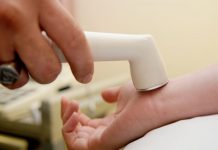Women are urged to perform breast self exams on a regular basis since this is a fairly effective means of detecting any lumps or anomalies of the breast that could mean the presence of cancer. Since early detection is the key to the successful treatment of any cancer, a breast self exam that detects a cancer early on can effectively help save lives.
 Similarly a testicular self exam could help men detect cancer of the testicles – which is perhaps a far less known fact than the fact that breast self exam could help detect cancer and hence may save lives.
Similarly a testicular self exam could help men detect cancer of the testicles – which is perhaps a far less known fact than the fact that breast self exam could help detect cancer and hence may save lives.
Since cancer of the testicles is rare, this is probably the information that is not as well known. Only one percent of all male cancers are cancers of the testicles.
However it is one of the more dangerous kinds of male cancers since it is most commonly seen among men aged between 16 and 35 years of age. No other male cancer is as common among men of this age.
So it is very important for men to perform a self exam of the testicles, in much the same way as a breast self exam is performed. A palpation of the tissue should be done each month to check for any unusual bumps, lumps, or other abnormalities. They could signal the early stages of testicle cancer, which is important to detect and arrest at an early stage since failing to do this could result in the cancer spreading to other areas. Ignoring a cancer of the testicles could result in death.
A famous sufferer of cancer of the testicles, cyclist Lance Armstrong (winner of the Tour de France) ignored his condition for a long time, which resulted in his cancer spreading considerably. Though he ultimately beat his cancer, he very nearly died from it.
A testicular cancer self exam is very important for the following men to perform –
- If one has a history of undescended testicles (which can be a birth defect or seen to occur in infants and young male children); particularly if the condition was not corrected. Parents should be vigilant about detecting this condition in their children.
- If one has a history of testicular cancer in the family or has an identical twin with the cancer.
- If one has sustained an injury to the testicles or the scrotum.
- If one is tall, slim and Caucasian (since white males are five times more likely than black males to have this cancer and tall and slim teens were seen to be most at risk)








